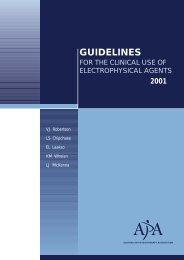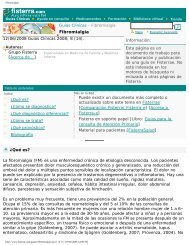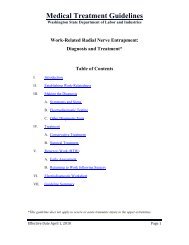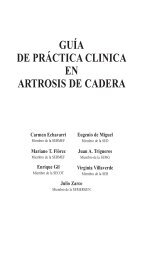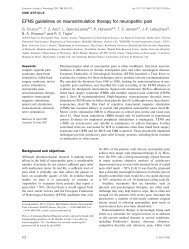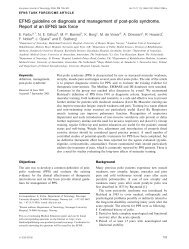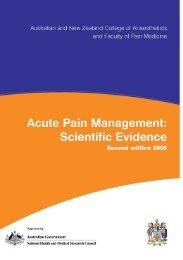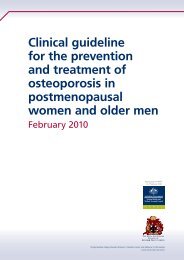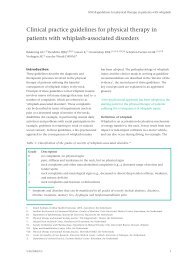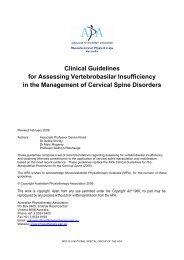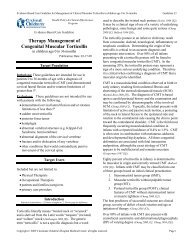Practice Parameter and Literature Review of the Usefulness of ...
Practice Parameter and Literature Review of the Usefulness of ...
Practice Parameter and Literature Review of the Usefulness of ...
You also want an ePaper? Increase the reach of your titles
YUMPU automatically turns print PDFs into web optimized ePapers that Google loves.
<strong>Practice</strong> <strong>Parameter</strong>: Carpal Tunnel Syndromemedian nerve, but also by pathology along <strong>the</strong> length <strong>of</strong> <strong>the</strong>median motor nerve fibers to <strong>the</strong> APB from <strong>the</strong> spinal cordto <strong>the</strong> wrist. For all <strong>the</strong>se reasons, measurements <strong>of</strong> F-wavelatencies <strong>and</strong> o<strong>the</strong>r F-wave parameters are notrecommended for <strong>the</strong> diagnosis <strong>of</strong> CTS.Buschbacher, 35 in a study that met 5 <strong>of</strong> <strong>the</strong> 6 AAEM LIC,reported <strong>the</strong> results <strong>of</strong> F-wave parameter in 195 referencesubjects. Fisher 73 (1997) used CTS as a model for analyzing<strong>the</strong> effects <strong>of</strong> focal nerve injury on F-wave parameters.Median Sensory NCSsMedian Sensory Nerve Conduction from Digit to Wrist.Table 11 presents <strong>the</strong> results <strong>of</strong> 6 studies <strong>of</strong> median sensoryNCSs <strong>of</strong> a 13 to 14 cm length <strong>of</strong> <strong>the</strong> median nerve with <strong>the</strong>proximal portion passing through <strong>the</strong> carpal tunnel (digitwriststudies). These 6 studies that met all 6 AAEM CTSLIC determined that between 40% <strong>and</strong> 74% <strong>of</strong> patients withCTS demonstrate ei<strong>the</strong>r a prolonged median sensory peaklatency or <strong>the</strong> median SNAP was absent. In a 1972 studythat met <strong>the</strong> 6 AAEM CTS LIC, Casey <strong>and</strong> LeQuesne 39reported a 94% incidence <strong>of</strong> abnormal median digit-wristsensory conduction: 15 out <strong>of</strong> 16 CTS patient studiesabnormal with 9 out <strong>of</strong> 16 absent SNAP <strong>and</strong> 6 out <strong>of</strong> 16reduced CV.There are 4 studies listed in Table 1 that provide mediansensory nerve conduction data in normal subjects whichsupport <strong>the</strong> choice <strong>of</strong> abnormal values in <strong>the</strong> 6 studies inTable 11 for median sensory peak latency, median sensoryonset latency, <strong>and</strong> median sensory CV (calculated from <strong>the</strong>onset latency <strong>and</strong> conduction distance). 34,58,110,242There were 19 o<strong>the</strong>r median sensory NCSs <strong>of</strong> <strong>the</strong> peaklatency, onset latency, <strong>and</strong> CV with conduction between <strong>the</strong>wrist <strong>and</strong> a digit (conduction distance <strong>of</strong> 13 to 14 cm) thatmet 4 or 5 <strong>of</strong> <strong>the</strong> AAEM CTS LIC with <strong>the</strong> followingincidence <strong>of</strong> abnormal findings (absent response, prolongedpeak or onset latency, or reduced CV) in patients with CTS:Andary <strong>and</strong> colleagues 9 (1996), 27%; Kothari <strong>and</strong>colleagues 135 (1995), D2 42% <strong>and</strong> D3 54%; White <strong>and</strong>colleagues 264 (1988), 44%, if a response could be elicited;Rosen 214 (1993), 48%; Mills 171 (1985), 53%; Sheean <strong>and</strong>colleagues 233 (1995), 55%; Stevens 243 (1987), 64%; Seror 228(1994), peak latency 61%, CV 66%; Preston <strong>and</strong>Logigian 200 (1992), 67%; Felsenthal 71 (1979), 70%;Trojaborg 253 (1996), D2 70% <strong>and</strong> D3 72%; Gunnarsson 91(1997), 77%; Melvin <strong>and</strong> colleagues 167 (1973), 79%;Marinacci 159 (1964), 83%; Monga <strong>and</strong> colleagues 174 (1985),86%; Kimura <strong>and</strong> Ayyar 131 (1985), 92%; Kemble 125 (1968),93%; Plaja 199 (1971), 98%; Merchut <strong>and</strong> colleagues 168(1990), 100%.While most authors used <strong>the</strong> index finger (Digit 2 or D2) forstimulation or recording, some prefer to use <strong>the</strong> middlefinger (Digit 3 or D3) instead <strong>of</strong> <strong>the</strong> index finger to evaluatemedian sensory conduction in CTS. 31,117,118,173,181,192,271 Thestudies that evaluated median digit-wrist sensory conductionwith several digits noted abnormalities in CTS patients more<strong>of</strong>ten with evaluation <strong>of</strong> <strong>the</strong> middle finger compared to <strong>the</strong>index finger, <strong>and</strong> evaluation <strong>of</strong> <strong>the</strong> thumb <strong>and</strong> sometimes <strong>the</strong>ring finger studies were more <strong>of</strong>ten abnormal than both <strong>the</strong>index <strong>and</strong> middle finger studies. 135,188,189,253There are 2 studies <strong>of</strong> median sensory conduction from digitto wrist in normal subjects that met 5 <strong>of</strong> <strong>the</strong> 6 AAEM CTSLIC: Stetson 242 (1994) D2 onset latency (3.0 ± 0.2 ms) <strong>and</strong>D2 sensory CV (SCV) (60.2 ± 4.9 m/s); Buschbacher 36onset (D2 = 2.6 ± 0.3 ms, D3 = 2.7 ± 0.3 ms) <strong>and</strong> peak (D2<strong>and</strong> D3 = 3.4 ± 0.3 ms) latencies, <strong>the</strong> Buschbacher 36 datapresents mean + 2 SD values higher than most <strong>of</strong> <strong>the</strong>reference values in <strong>the</strong> 7 studies in Table 11.Median Sensory Conduction from <strong>the</strong> Palm to <strong>the</strong> Wrist.Table 12 presents <strong>the</strong> results <strong>of</strong> 7 studies <strong>of</strong> median sensory<strong>and</strong>/or mixed NCSs <strong>of</strong> an 8-cm length <strong>of</strong> <strong>the</strong> median nervepassing through <strong>the</strong> carpal tunnel. These 7 studies that metall 6 AAEM CTS LIC determined that between 67% <strong>and</strong>84% <strong>of</strong> patients with CTS demonstrate a prolonged medianpeak latency, onset latency, or CV with a conductiondistance <strong>of</strong> 8 cm.In Table 1, <strong>the</strong>re are 4 studies <strong>of</strong> median sensory <strong>and</strong>/ormixed nerve conduction between <strong>the</strong> wrist <strong>and</strong> palm innormal subjects. Using a technique to study <strong>the</strong> conduction<strong>of</strong> <strong>the</strong> wrist-palm median nerve segment similar toKimura, 130 Di Benedetto <strong>and</strong> colleagues 58 reported adifference in peak latency in healthy subjects <strong>of</strong> less than 2.2ms, <strong>and</strong> a difference in onset latency in healthy subjects <strong>of</strong>less than 1.8 ms, <strong>the</strong> latter value almost identical to <strong>the</strong>finding <strong>of</strong> Kimura 130 in Table 12. Cruz Martinez <strong>and</strong>colleagues 50 calculated <strong>the</strong> CV in palm-to-wrist segments <strong>of</strong><strong>the</strong> median nerve from <strong>the</strong> onset latency in 47 normalsubjects, aged 21 to 77 Under <strong>the</strong> age <strong>of</strong> 50, <strong>the</strong> mediansensory CV was 55 ± 5 m/s, <strong>and</strong> over <strong>the</strong> age <strong>of</strong> 50, <strong>the</strong>median sensory CV was 51 ± 5 m/s. Stetson 242 in a study <strong>of</strong>105 normal subjects noted an onset latency <strong>of</strong> 1.8 ± 0.2 ms.Buschbacher 33 in a study <strong>of</strong> 248 normal subjects reported anonset latency <strong>of</strong> 1.6 ± 0.2 ms <strong>and</strong> a peak latency <strong>of</strong> 2.1 ± 0.2ms.There were 15 additional studies that report median mixednerve conduction over a 7 cm to 8 cm distance across <strong>the</strong>carpal tunnel that met 4 or 5 <strong>of</strong> <strong>the</strong> 6 AAEM CTS LIC with<strong>the</strong> following incidence <strong>of</strong> abnormal findings in patientswith CTS: Kimura 121 (1978), 45%; Andary <strong>and</strong> colleagues 9(1996), 57%; White <strong>and</strong> colleagues 264 (1988), 65%, a studythat ignored cases with absent responses; Mills 171 (1985),67%; Robinson <strong>and</strong> colleagues 211 (1998) 70%; Sheean <strong>and</strong>colleagues 233 (1995), 73%; Seror 228 (1994), 76%; Preston<strong>and</strong> Logigian 200 (1992), 82%; Stevens 243 (1987), 87%;Monga <strong>and</strong> colleagues 174 (1985), 88%; Felsenthal <strong>and</strong>Spindler 71 (1979), 100%; Wongsam 271 (1983), 100%;Muscle & Nerve Supplement X 2002 S939



